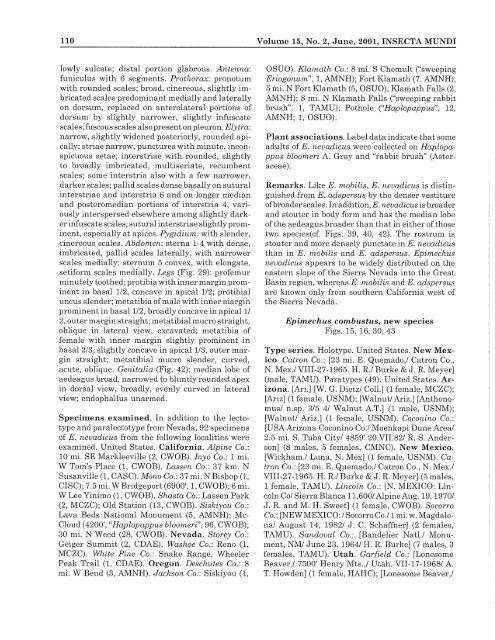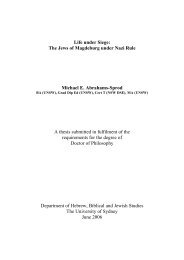Epimechus Dietz (Coleoptera: Curculionidae: Anthonomini)
Epimechus Dietz (Coleoptera: Curculionidae: Anthonomini)
Epimechus Dietz (Coleoptera: Curculionidae: Anthonomini)
Create successful ePaper yourself
Turn your PDF publications into a flip-book with our unique Google optimized e-Paper software.
110<br />
lowly sulcate; distal portion glabrous. Antenna:<br />
funiculus with 6 segments. Prothorax: pronotum<br />
with rounded scales; broad, cinereous, slightly imbricated<br />
scales predominant medially and laterally<br />
on dorsum, replaced on anterolateral portions of<br />
dorsum by slightly narrower, slightly infuscate<br />
scales; fuscous scales also present on pleuron. Elytra:<br />
narrow, slightly widened posteriorly, rounded apically;<br />
striae narrow, punctures with minute, inconspicuous<br />
setae; interstriae with rounded, slightly<br />
to broadly imbricated, multiseriate, recumbent<br />
scales; some interstria also with a few narrower,<br />
darker scales; pallid scales dense basally on sutural<br />
interstriae and inters tria 6 and on longer median<br />
and posteromedian portions of interstria 4, variously<br />
interspersed elsewhere among slightly darker<br />
infuscate scales; sutural inter striae slightly prominent,<br />
especially at apices. Pygidium: with slender,<br />
cinereous scales. Abdomen: sterna 1-4 with dense,<br />
imbricated, pallid scales laterally, with narrower<br />
scales medially; sternum 5 convex, with elongate,<br />
setiform scales medially. Legs (Fig. 29): profemur<br />
minutely toothed; protibia with inner margin prominent<br />
in basal 112, concave in apical 1/2; protibial<br />
uncus slender; metatibia of male with inner margin<br />
prominent in basal 1/2, broadly concave in apical 11<br />
2, outer margin straight; metatibial mucro straight,<br />
oblique in lateral view, excavated; metatibia of<br />
female with inner margin slightly prominent in<br />
basal 2/3, slightly concave in apical 113, outer margin<br />
straight; metatibial mucro slender, curved,<br />
acute, oblique. Genitalia (Fig. 42): median lobe of<br />
aedeagus broad, narrowed to bluntly rounded apex<br />
in dorsal view, broadly, evenly curved in lateral<br />
view; endophallus unarmed.<br />
Specimens examined. In addition to the lectotype<br />
and paralectotype from Nevada, 92 specimens<br />
of E. nevadicus from the following localities were<br />
examined. United States. California. Alpine Co.:<br />
10 mi. SE Markleeville (2, CWOB). 1nyo Co.: 1 mi.<br />
W Tom's Place (1, CWOB). Lassen Co.: 37 km. N<br />
Susanville (1, CASC). Mono Co.: 37 mi. N Bishop (1,<br />
CISC); 7.5 mi. W Bridgeport (6900',1, CWOB); 6 mi.<br />
W Lee Yinimo (1, CWOB). Shasta Co.: Lassen Park<br />
(2, MCZC); Old Station (13, CWOB). Siskiyou Co.:<br />
Lava Beds National Monument (5, AMNH); Mc<br />
Cloud (4200', "Haplopappus bloomeri", 96, CWOB);<br />
30 mi. N Weed (28, CWOB). Nevada. Storey Co.:<br />
Geiger Summit (2, CDAE). Washoe Co.: Reno (1,<br />
MCZC). White Pine Co.: Snake Range, Wheeler<br />
Peak Trail (1, CDAE). Oregon. Deschutes Co.: 8<br />
mi. W Bend (3, AMNH). Jackson Co.: Siskiyou (1,<br />
Volume 15, No.2, June, 2001, INSECTA MUNDI<br />
OSUO). Klamath Co.: 8 mi. S Chemult ("sweeping<br />
Eriogonum", 1, AMNH); Fort Klamath (7, AMNH);<br />
5 mi. N Fort Klamath (5, OSUO); Klamath Falls (2,<br />
AMNH); 8 mi. N Klamath Falls ("sweeping rabbit<br />
brush", 1, TAMU); Pothole ("Haplopappus", 12,<br />
AMNH; 1, OSUO).<br />
Plant associations. Label data indicate that some<br />
adults of E. nevadicus were collected on Haplopappus<br />
bloomeri A. Gray and "rabbit brush" (Asteraceae).<br />
Remarks. Like E. mobilis, E. nevadicus is distinguished<br />
from E. adspersus by the denser vestiture<br />
of broader scales. In addition, E. nevadicus is broader<br />
and stouter in body form and has the median lobe<br />
of the aedeagus broader than that in either of those<br />
two species(cf. Figs. 39, 40, 42). The rostrum is<br />
stouter and more densely punctate in E. nevadicus<br />
than in E. mobilis and E. adspersus. <strong>Epimechus</strong><br />
nevadicus appears to be widely distributed on the<br />
eastern slope of the Sierra Nevada into the Great<br />
Basin region, whereas E. mobilis and E. adspersus<br />
are known only from southern California west of<br />
the Sierra Nevada.<br />
<strong>Epimechus</strong> combustus, new species<br />
Figs. 15, 16, 30, 43<br />
Type series. Holotype. United States. New Mexico.<br />
Catron Co.: [23 mi. E. Quemado,! Catron Co.,<br />
N. Mex.!VIII-27-1965. H. R.! Burke & J. R. Meyer]<br />
(male, TAMU). Paratypes (49). United States. Arizona.<br />
[Ari.] [W. G. <strong>Dietz</strong>/ Coll.] (1 female, MCZC);<br />
[Ariz] (1 female, USNM); [Walnut/ Ariz.] [Anthonomus/<br />
n.sp. 3/5 4/ Walnut A.T.] (1 male, USNM);<br />
[Walnut/ Ariz.] (1 female, USNM). Coconino Co.:<br />
[USA Arizona Coconino Co.! Moenkapi Dune Area/<br />
2.5 mi. S. Tuba City/ 4859' 20.VII.82/ R. S. Anderson]<br />
(8 males, 5 females, CMNC). New Mexico.<br />
[Wickham.! Luna, N. Mex] (1 female, USNM). Catron<br />
Co.: [23 mi. E. Quemado,! Catron Co., N. Mex.!<br />
VIII-27-1965. H. R.! Burke & J. R. Meyer] (5 males,<br />
1 female, TAMU). Lincoln Co.: [N. MEXICO: Lincoln<br />
Col Sierra Blanca 11,600/ Alpine Aug. 19, 1970/<br />
J. R. and M. H. Sweet] (1 female, CWOB). Socorro<br />
Co.: [NEWMEXICO:/SocorroCo.!lmi. w.Magdalena/<br />
August 14, 1982/ J. C. Schaffner] (2 females,<br />
TAMU). Sandoval Co.: [Bandelier Natl.l Monument,<br />
NM/ June 23,1964/ H. R. Burke] (7 males, 3<br />
females, TAMU). Utah. Garfield Co.: [Lonesome<br />
Beaver,! 7500' Henry Mts.,! Utah. VII-17-1968/ A.<br />
T. Howden] (1 female, HAHC); [Lonesome Beaver,!
















